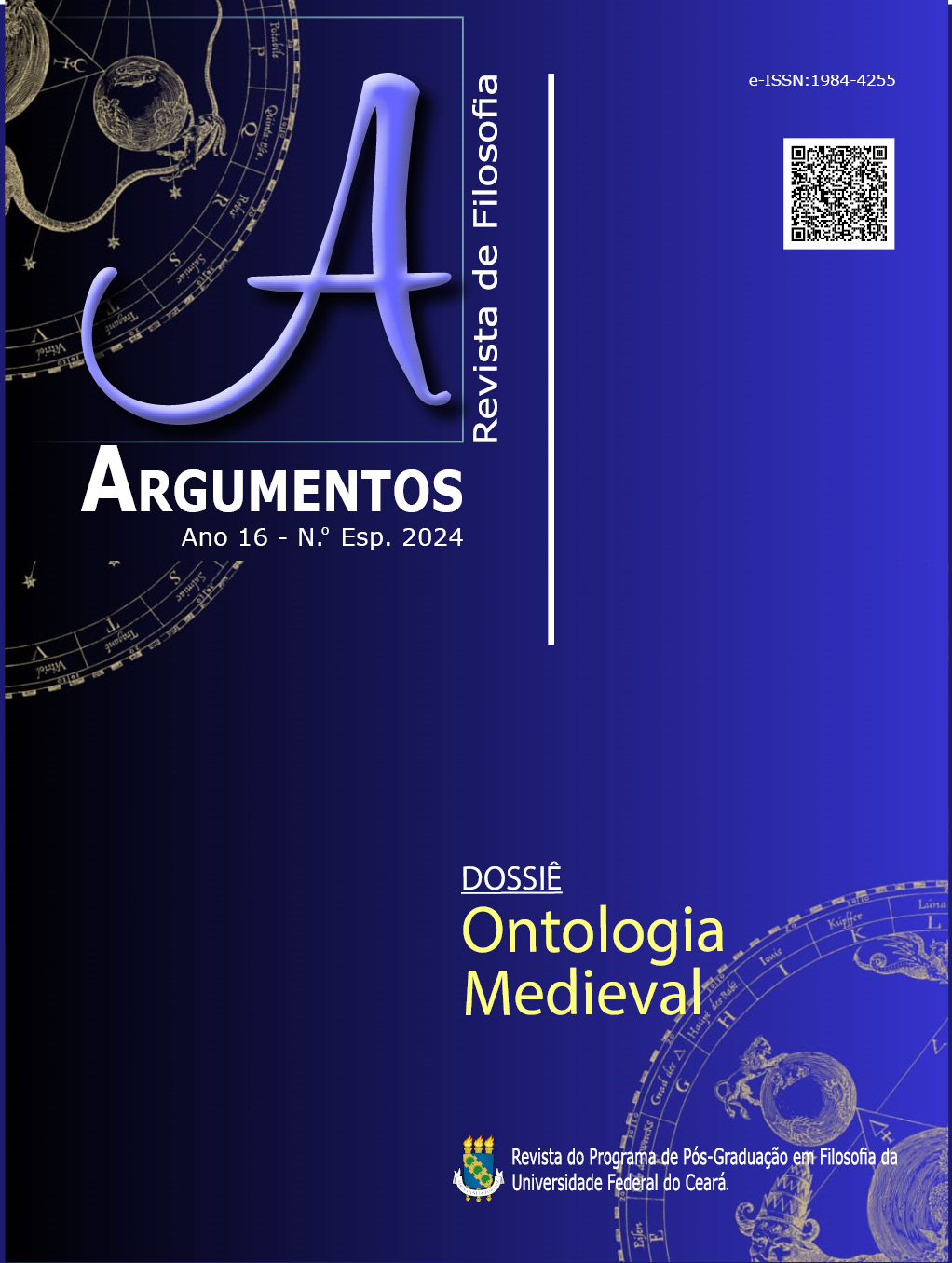Between ontology and henology: Ibn Gabirol’s dynamic metaphysics
Keywords:
Ibn Gabirol. Matéria. Forma. Dialética. Fluxo.Abstract
Schlomo Ibn Gabirol (Avicebron), medieval Spanish jew under Islamic rule was a heterodox and original thinker in all areas in which he worked. Banished from the Jewish community in 1045 by a herem, there is no reliable information about his life since then. During this period, he would have written his fundamental metaphysical work, whose Arabic original is lost and only the Latin translation (Fons Vitae) has survived until our days. In this work he describes the reality of the created world from a universal composition of matter and form. Behind its markedly Aristotelian language, it presents a Neoplatonic model in which matter and form interact dynamically to form intelligible and sensible realities. In this paper we intend to show that, neither exactly an ontology nor exactly a henology, Ibn Gabirol’s dynamic metaphysics unfolds from a very peculiar radical dialectic in which there are no fixed elements.
References
AVENCEBROLIS (IBN GABIROL). Fons Vitae – ex Arabico in Latinum translatum ab Iohanne Hispano et Dominico Gundissalino. Ex codicis Parisinis, Amploniano, Columbino primum edidit Clemens Baeumker. Beiträge zur Geschichte der Philosophie des Mittelalters. Münster: Aschendorff, 1895.
ASÍN PALACIOS, M. The mystical philosophy of Ibn Masarra and his followers. Translated by Elmer H. Douglas and Howard W. Yoder. Leiden: E. J. Brill, 1978.
DAL BO, F. “Ibn Gabirol Between Philosophy and Kabbalah. A Comprehensive Insight into the Jewish Reception of Ibn Gabirol”. In: POLLONI; BENEDETTO; DAL BO. Ibn Gabirol (Avicebron): Latin and Hebrew Philosophical Traditions. Turnhout: Brepols, 2023. p. 359-382.
DE SMET, D. Empedocles Arabus, une lecture Neoplatonicienne tardive. Brussels: Koninkluke Academie Voor Wetenschappen, Letteren en Schone Kunsten van Belgie, 1998.
FERNANDES, E. A interação naturante entre o demiurgo e o mundo, a questão dos “dois tipos de matéria” e a natureza da “implantação” da alma no corpo. Kriterion, Belo Horizonte, n. 122, dez./2010, p. 617-635.
FRICK, P. Divine providence in Philo of Alexandria. Tübingen: Mohr Siebeck: 1999.
IBN GABIROL; LEWIS, B. The Kingly Crown. Tradução, Introdução e notas de Bernard Lewis. London: Valentine-Mitchell, 1961.
LAUMAKIS, J. A. Solomon Ibn Gabirol and William of Auvergne. In: POLLONI; BENEDETTO; DAL BO. Ibn Gabirol (Avicebron): Latin and Hebrew Philosophical Traditions. Turnhout: Brepols, 2023, p. 159-196.
MUNK, S. Mélanges de Philosophie Juïve et, Arabe. Paris: Librairie philosophique J. Vrin, 1927.
PESSIN, S. Ibn Gabirol’s Theology of Desire. Matter and Method in Jewish Medieval Neoplatonism. Cambridge: Cambridge University Press, 2013.
STERN. S.M. Ibn Masarra, follower of Pseudo-Empedocles – an illusion. In: ZIMMERMAN, F. (Ed.). Medieval Arabic and Hebrew Thought. London: Variorum, 1983. Originalmente publicado em: Actas, 4º Congresso de Estudos Árabes e Islâmicos, Coimbra-Lisboa 1968 (Leiden: Brill, 1971).
STRAUSS, Z. “‘Lord, Show us the One, an it is Enough for Us’. Meister Eckhart’s Reception of Ibn Gabirol’s Metaphisics of the One”. In: POLLONI; BENEDETTO; DAL BO. Ibn Gabirol (Avicebron): Latin and Hebrew Philosophical Traditions. Turnhout: Brepols, 2023. p. 283-315.
STROUMSA, S. “‘Wondrous Paths’: The Ismāʿīlī Context of Saadya’s ‘Commentary on Sefer Yetsira’” Bochumer Philosophisches Jahrbuch für Antike und Mittelalter, v. 18, n. 1, 2015, p. 74-90.
STROUMSA, S.; SVIRI, S. The Beginnings of Mystical Philosophy in Al-Andalus: Ibn Masarra and his Epistle on Contemplation. Jerusalem Studies in Arabic and Islam (JSAI), v. 36, 2009, p. 201-253.
ZINGANO, M. Forma, Matéria e Definição na Metafísica de Aristóteles. Cad. Hist. Fil. Ci., Campinas, Série 3, v. 13, n. 2, jul./dez. 2003, p. 277-299.
Downloads
Published
Issue
Section
License
Copyright (c) 2024 Cecilia Cintra Cavaleiro de Macedo

This work is licensed under a Creative Commons Attribution 4.0 International License.
Argumentos magazine is licensed under an International Creative Commons Attribution License.
The Magazine uses CC BY inclusion
1) The authors retain the copyright granted to the magazine or the right to initial publication, with the work regularly licensed under the Creative Commons Attribution, which allows the sharing of the work with acknowledgment of authorship and initial publication in this magazine.
2) The authors are authorized to contract additional applicable contracts, for non-exclusive distribution of the version of the work published in this journal (for example, publication in the institutional repository or as a chapter of the book), recognition of authorship and initial publication in this journal.
3) Authors are authorized and encourage to publish and distribute their work online (for example, in institutional repositories or on their personal pages) at any time before or during the editorial process, as they can generate productive changes, as well as increase the impact and reference of published work.




.jpg)










._._3.png)
1.jpg)
._._._.png)
